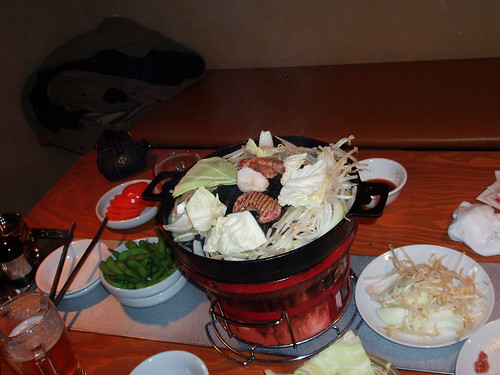
Photo by tetu
Ezo red fox is a subspecies found almost exclusively in Hokkaido.
Partway through the drive, we stopped for some Genghis Khan, or mutton cooked on a convex metal skillet, supposedly the way the Mongols cooked on their helmets back in the day. The dish is popular in Hokkaido.
This is what ours looked like:

Photo by Nemo's Great Uncle
We stayed at Lake Akan, where there is a hot spring resort and "Ainu Kotan," a village ("kotan" means "village" in the Ainu language) with a lot of tourist shops selling Ainu folk art and an Ainu museum. The Ainu are the native people of Hokkaido.
That brings me to the (possibly) controversial part of this post, because one of the things they sell in the village is bear carvings. Traditionally, bear carvings were reserved for religious items such as prayer sticks and headdresses. When ethnic Japanese took over Hokkaido in the late 1800s, they declared that the Ainu were Japanese subjects, and outlawed Ainu language and customs, including hunting and fishing, so the Ainu had no way to make a living. The Ainu people who worked for Japanese logging companies were viewed as dogs - less than human. Some Ainu turned to wood carving as a way to survive. They took what had been religious items and sold them as tourist souvenirs. Umetaro Matsui, an Ainu bear hunter, became a well-known carver of wooden bears.
Source: Old Photos of Japan
Posta Collect, in their description of the bear carving, completely erase the Ainu. According to Posta Collect, the image originated in souvenirs brought to Japan from Europe. They mention Umetaro Matsui, but not that he was Ainu. Shame on you, Posta Collect. This is a stunningly obvious example of the racism faced by the Ainu today.
No wonder this bear looks like he is crying.

Photo by Sebastian Tauchmann



This comment has been removed by a blog administrator.
ReplyDeleteAll spam comments will be deleted immediately.
ReplyDeleteOh, I missed this blog! Happy to see more gotochi cards!
ReplyDeleteHi Maggie,
ReplyDeleteI’m glad to have found your blog, since we share a liking to animal-themed collectibles. Yours is postcards, while I collect stamps. Speaking of foxes, what I like about Japan’s perspective of them through the anime stories I’ve been watching is that they are always depicted as crafty and intelligent, thus the idiom “as sly as a fox”. What I liked about the myths of Japan (and other Asian countries) about the fox is that they have this unique nine-tailed fox. I’m sure those who are familiar with Pokemon would know about Ninetales. I checked an online stamp catalogue, and found in Japan a stamp showing a pair of Arctic Foxes in summer (brown fur) and it was issued on May 29, 1992. They are Hokkaido prefectural stamps.